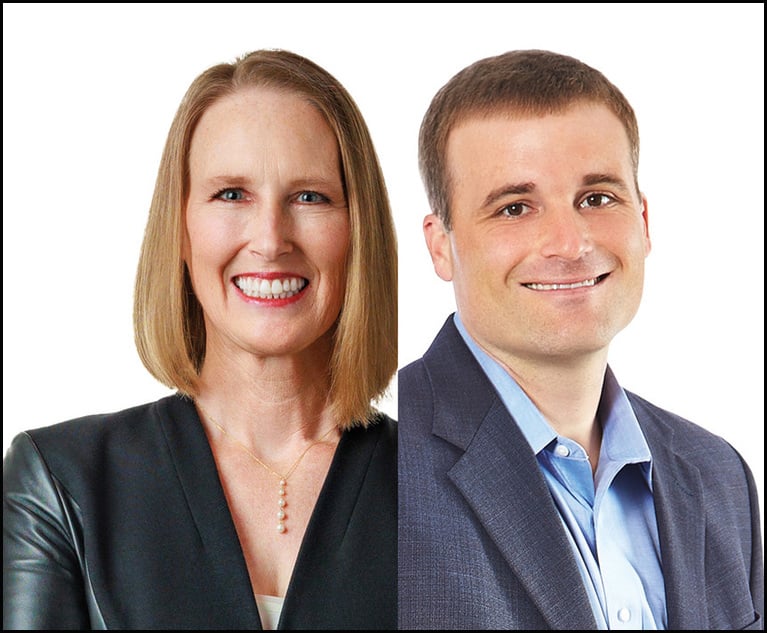How Can Big Law Overcome Its Persistent Diversity Problem?
At a Baker & Hostetler event, Beverly Tatum, president emerita of Spelman College, made concrete suggestions for recruitment strategies.
February 19, 2020 at 03:03 PM
4 minute read
 (Photo: Robert Kneschke/Shutterstock.com)
(Photo: Robert Kneschke/Shutterstock.com)
Law firms, like other businesses, serve a client base that is increasingly nonwhite, making the business case for diversity even more urgent—and yet large firms have made little progress in increasing their number of lawyers of color.
Beverly Tatum, president emerita of Spelman College, said that 90% of the U.S. population was white in 1954, the year she was born, but by 2000, when today's 20-year-olds were born, white people made up only 52% of the population.
"Are you going to be successful as a law firm if you look like you were born in 1954?" she asked at a Black History Month event Tuesday at Baker & Hostetler in Atlanta.
As the event's featured speaker, Tatum made concrete suggestions for better recruitment strategies in a conversation with Atlanta news anchor Jovita Moore of WSB-TV.
Tatum, a psychologist and educator, wrote the landmark book on race in America "Why Are All the Black Kids Sitting Together in the Cafeteria?" in 1997 and updated it in 2017. While the United States has rapidly been growing more diverse, she said, old patterns of racial bias persist, which has prompted researchers to increase the focus on the effects of unconscious bias.
Moore pointed out that the disproportionately low percentage of African American attorneys in Big Law has persisted despite firms' greater emphasis on diversity and inclusion efforts.
Only 4.8% of Big Law associates are African American, and that drops to 2% for partners, according to NALP's most recent report on diversity in 2019. Overall, lawyers of color make up 25.4% of associates but only 9.6% of partners in Big Law.
"It's 2020. Why are we still talking about this?" Moore asked.
It's important to recognize that unconscious bias, as opposed to overt discrimination, often plays a role in hiring decisions, Tatum said. People have a bias toward choosing candidates who are similar to themselves, whether in race, gender or where they went to school, she explained, so for white people making hiring decisions, white preference can play a role.
"Those biases add up over time," Tatum said.
The term "affirmative action" has fallen out of favor, she added, because it is often used interchangeably with quotas, which are illegal in many cases, but firms need to take an affirmative approach to diversity. "You need intentionality in hiring decisions," she said.
At a basic level that means clearly defining recruitment goals, Tatum said, noting that firms often use "diverse candidates" to mean candidates of color, and, more specifically, black candidates. "So say that," she advised.
To expand the candidate pool Tatum suggested seeking out lawyers from law schools with more diverse student bodies, such as Howard University or, locally, Georgia State University.
After establishing a pool of fit candidates, firms should select those that meet their diversity goals, Tatum said, adding that Leadership Atlanta is a good example of this approach. After assembling a qualified applicant pool, the leadership development program intentionally uses diversity as a selection criterion for each year's class.
Defining 'Best' Candidates
A firm might experience internal pushback in taking this approach from those saying it should hire "the best" candidates—which raises the question of how "best" is being defined, Tatum said. "Does it mean someone who went to the same school as those doing the hiring—or someone who diversifies the team?"
For that reason, Tatum said, it's important for firms to clearly state their recruitment criteria: Do they want graduates from certain law schools, for instance—or candidates who advance a business goal of diversity?
Tatum made a distinction between affirmatively hiring for diversity in a process-oriented or a goal-oriented way, explaining that "process-oriented" describes assembling a diverse pool and then charging decision-makers with choosing the "best" candidates from the pool.
"The problem is that you get more of the same," she said of that approach, since that's where bias kicks in. The hiring managers generally select applicants similar to themselves, she said. "The process looks like it's fair, but the outcome is the same."
Instead, goal-oriented affirmative action focuses on outcomes, Tatum said. If the organization's goal is to diversify the employee base, and all of the candidates in the pool have been deemed qualified, she explained, the hirers can focus on choosing candidates that diversify their teams.
"That's how you get the team from 2% to 3% African American—and then from 3% to 5%," she said.
This content has been archived. It is available through our partners, LexisNexis® and Bloomberg Law.
To view this content, please continue to their sites.
Not a Lexis Subscriber?
Subscribe Now
Not a Bloomberg Law Subscriber?
Subscribe Now
NOT FOR REPRINT
© 2025 ALM Global, LLC, All Rights Reserved. Request academic re-use from www.copyright.com. All other uses, submit a request to [email protected]. For more information visit Asset & Logo Licensing.
You Might Like
View All



Alston & Bird, Baker Hostetler, Holland & Knight Promote Partners in Southeast
5 minute readTrending Stories
- 1'It's Not Going to Be Pretty': PayPal, Capital One Face Novel Class Actions Over 'Poaching' Commissions Owed Influencers
- 211th Circuit Rejects Trump's Emergency Request as DOJ Prepares to Release Special Counsel's Final Report
- 3Supreme Court Takes Up Challenge to ACA Task Force
- 4'Tragedy of Unspeakable Proportions:' Could Edison, DWP, Face Lawsuits Over LA Wildfires?
- 5Meta Pulls Plug on DEI Programs
Who Got The Work
Michael G. Bongiorno, Andrew Scott Dulberg and Elizabeth E. Driscoll from Wilmer Cutler Pickering Hale and Dorr have stepped in to represent Symbotic Inc., an A.I.-enabled technology platform that focuses on increasing supply chain efficiency, and other defendants in a pending shareholder derivative lawsuit. The case, filed Oct. 2 in Massachusetts District Court by the Brown Law Firm on behalf of Stephen Austen, accuses certain officers and directors of misleading investors in regard to Symbotic's potential for margin growth by failing to disclose that the company was not equipped to timely deploy its systems or manage expenses through project delays. The case, assigned to U.S. District Judge Nathaniel M. Gorton, is 1:24-cv-12522, Austen v. Cohen et al.
Who Got The Work
Edmund Polubinski and Marie Killmond of Davis Polk & Wardwell have entered appearances for data platform software development company MongoDB and other defendants in a pending shareholder derivative lawsuit. The action, filed Oct. 7 in New York Southern District Court by the Brown Law Firm, accuses the company's directors and/or officers of falsely expressing confidence in the company’s restructuring of its sales incentive plan and downplaying the severity of decreases in its upfront commitments. The case is 1:24-cv-07594, Roy v. Ittycheria et al.
Who Got The Work
Amy O. Bruchs and Kurt F. Ellison of Michael Best & Friedrich have entered appearances for Epic Systems Corp. in a pending employment discrimination lawsuit. The suit was filed Sept. 7 in Wisconsin Western District Court by Levine Eisberner LLC and Siri & Glimstad on behalf of a project manager who claims that he was wrongfully terminated after applying for a religious exemption to the defendant's COVID-19 vaccine mandate. The case, assigned to U.S. Magistrate Judge Anita Marie Boor, is 3:24-cv-00630, Secker, Nathan v. Epic Systems Corporation.
Who Got The Work
David X. Sullivan, Thomas J. Finn and Gregory A. Hall from McCarter & English have entered appearances for Sunrun Installation Services in a pending civil rights lawsuit. The complaint was filed Sept. 4 in Connecticut District Court by attorney Robert M. Berke on behalf of former employee George Edward Steins, who was arrested and charged with employing an unregistered home improvement salesperson. The complaint alleges that had Sunrun informed the Connecticut Department of Consumer Protection that the plaintiff's employment had ended in 2017 and that he no longer held Sunrun's home improvement contractor license, he would not have been hit with charges, which were dismissed in May 2024. The case, assigned to U.S. District Judge Jeffrey A. Meyer, is 3:24-cv-01423, Steins v. Sunrun, Inc. et al.
Who Got The Work
Greenberg Traurig shareholder Joshua L. Raskin has entered an appearance for boohoo.com UK Ltd. in a pending patent infringement lawsuit. The suit, filed Sept. 3 in Texas Eastern District Court by Rozier Hardt McDonough on behalf of Alto Dynamics, asserts five patents related to an online shopping platform. The case, assigned to U.S. District Judge Rodney Gilstrap, is 2:24-cv-00719, Alto Dynamics, LLC v. boohoo.com UK Limited.
Featured Firms
Law Offices of Gary Martin Hays & Associates, P.C.
(470) 294-1674
Law Offices of Mark E. Salomone
(857) 444-6468
Smith & Hassler
(713) 739-1250






